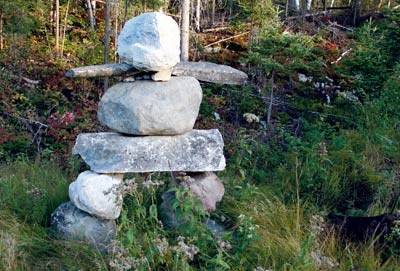Even though some Inukshuks seem to have the proper anatomy, it’s impossible for the rock figures to reproduce. Yet, they seem to be multiplying quite efficiently along Highway 69.
Returning to Sudbury from a recent trip south, I counted 93 between the Georgian Bay Welcome Centre and the city’s South End. That does not include mounds of rock where Inukshuks likely stood before.
While each Inukshuk is unique — whether because of its size, shape, colour, accessories or location — they all have the same distinct outline, which originated in Canada’s north.
William Morin, a local artist and educator, said Inukshuks were typically created by Inuit people “above the tree line” to aid hunters by acting as markers. Inukshuks are also used to welcome visitors to the region.

I’d be staggered if most didn’t have some sort of meaning behind them.
Phil Andrews,
constructed two Inukshuks on Hwy. 69
The stones used to make Inukshuks could also be put to other uses, Morin said. In case of bad weather, the structures could be disassembled to make shelters for people passing by. “It would be the one item that would be there that could endure the elements,” he said.
While the Inukshuk has taken on the role of representing Canada and the north, most notably during the Vancouver Olympics, Morin said much of their traditional value has been lost.
“Just like much of the primitive cultures around the world, certain elements, like the yin-yang symbol of Chinese culture ... is tattooed on everybody’s body. It’s the symbols from (other) cultures that become adopted, taken to mean whatever it means.”
Morin said since Inukshuks started sprouting up on Highway 69 in the 1980s, many of them sport personalized characteristics, which he said he believes is “out of intent to be silly.”
When Phil Andrews, managing editor of the Guelph Mercury, built an Inukshuk along the northern highway, it wasn’t without purpose. But it had nothing to do with the traditional Inuit meaning either. The Sudbury native built his first Inukshuk last May after his godfather, Moe Farrell’s funeral.
After noting the creations for years with his family, Andrews said the solo drive back to southern Ontario was an appropriate time to build one of his own. “I had this ‘fill the dreams’ moment where I needed to stop and do it.”
Earlier this month, following his godmother Ginny Farrell’s funeral, Andrews made another Inukshuk. The two structures can now be seen standing next to each other along the road.
Andrews said he thinks “the Inukshukification of Highway 69” has some sort of significance, even if it’s not the one Morin speaks of.
“I’d be staggered if most didn’t have some sort of meaning behind them,” he said. “It’s kind of incredible to think about the drive if that is the case.”
Morin said because of the growing number of Inukshuks along the highway, more people might be inclined to learn more about them.
Although they might be far from their originals, the contemporary Inukshuks along Highway 69 do still serve a purpose as they represent special people and memories, instead of territories and hunting marks.
